Planning to invest in a mobile app to enhance your brand’s reach and customer engagement? It’s a perfect time!
According to mobile data and analytics firm Data.Ai, mobile app usage has surged by 40% since 2019, with people spending an average of 4.2 hours per day on their smartphones.
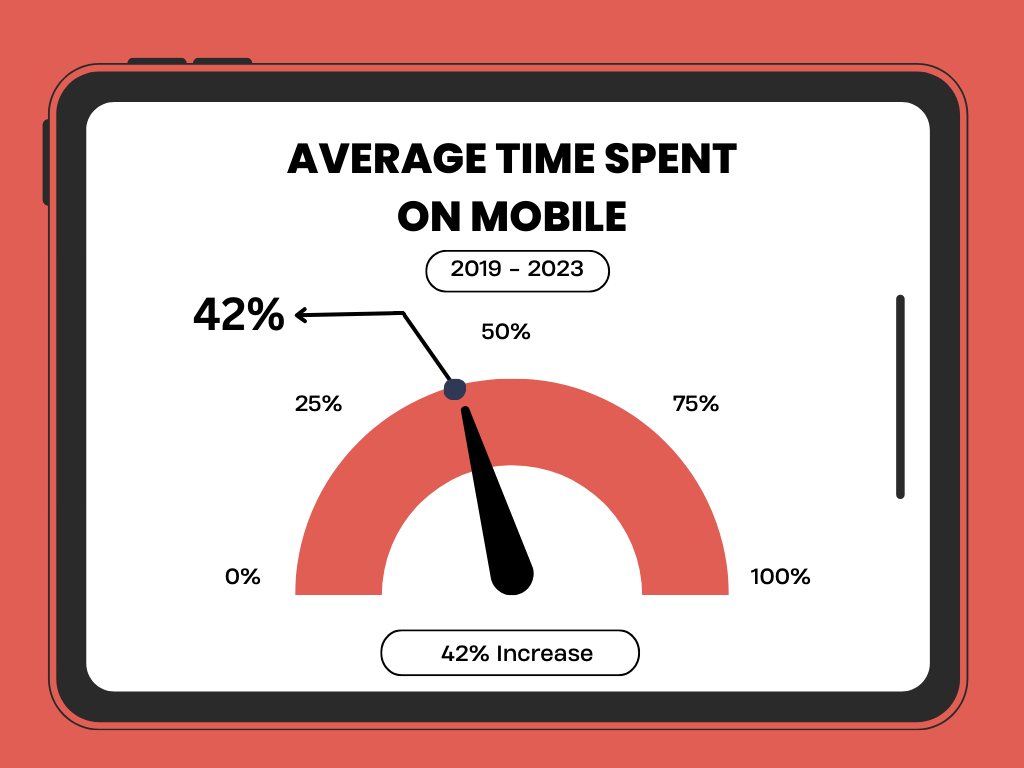
In fact, as per a recent report published by Statista on March 30, 2023, there are 6.6 billion smartphone network subscriptions worldwide. This number is predicted to hit 7.8 billion by 2028.
However, as with any investment, it’s important to consider the costs involved in developing a mobile app. As of 2023, the average cost of a mobile app ranges from $50,000 to $250,000, with more complex apps costing upwards of $500,000!

To ensure that your investment is well spent, you need to work with a reputable app development company that can provide transparent pricing and a clear explanation of the development process.
In this article, we will dive deeper into the cost of developing mobile apps in 2023 and explore the factors that impact these costs.
Average Cost of Developing a Mobile App
So, you’re thinking about developing a mobile app for your business. But how much is it going to cost you? Well, the truth is, there’s no one-size-fits-all answer to that question.
The cost of developing an app depends on a plethora of factors, such as the type of app, its complexity, and the platform it is being developed for, among other things.
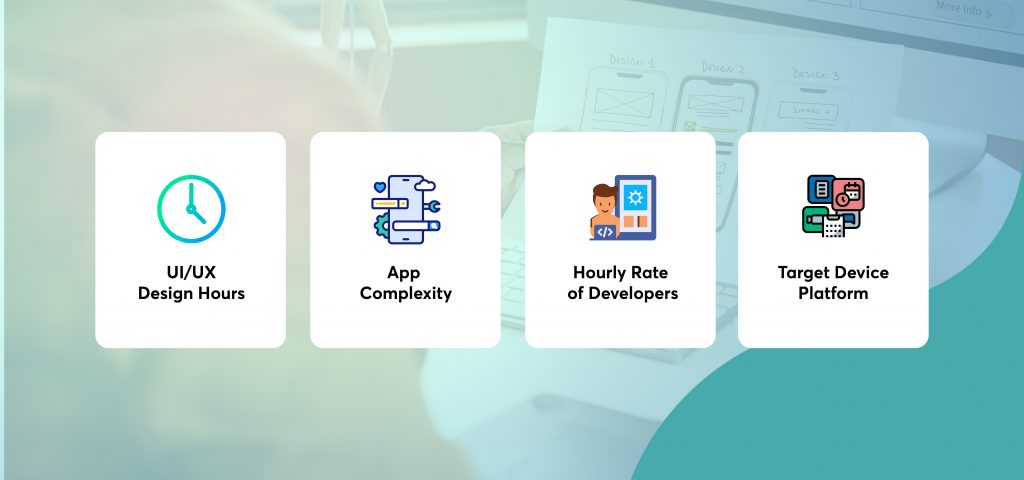
Other factors influencing the cost of app development include the location of the development team and the amount of customization required. For example, hiring a development team in North America or Europe may be more expensive than outsourcing to a team in Asia. Additionally, more complex apps require more time and resources to develop, which can drive up costs.
In the next section, we will have a quick look at the factors that can influence the cost of app development, helping you to better understand the costs involved in bringing your mobile app idea to life.
5 Factors that Affect the Cost of Developing a Mobile App
Developing a mobile app is a costly endeavor. Understanding the factors that affect the cost is crucial to creating a realistic budget. In this section, we’ll discuss five key factors that impact the cost of mobile app development.
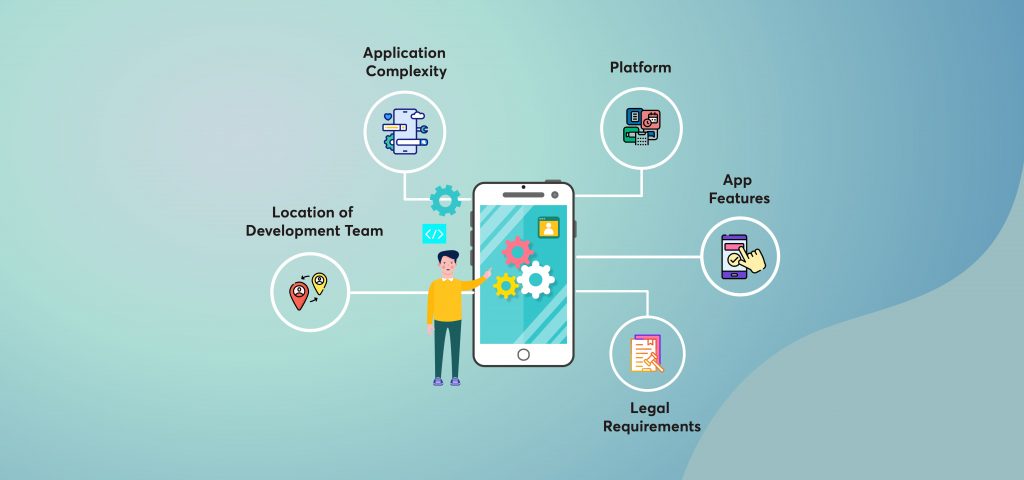
#1. Application Complexity
The more features and functionalities your app has, the more complex it becomes. When it comes to app complexity, it can be helpful to think in terms of three categories: simple (MVP), medium, and complex.
Here’s what you can expect in terms of cost for each category:
- Simple apps – $50,000 to $100,000
Simple mobile applications are often referred to as minimum viable products (MVPs). As the name suggests, they focus only on providing the most essential features and functionality necessary for the app’s purpose.

These apps typically have a straightforward interface, with minimal design elements and a limited number of features. An example of an MVP app might be a calculator app or a to-do list app.
The cost of developing a simple app can range from $50,000 to $100,000.
- Medium apps – $100,000 to $250,000
Medium or moderately complex apps come with more advanced features and functionalities than simple applications but are less complex than fully featured apps. Fitness apps like Nike Training Club and FitOn are some popular examples of moderately complex apps.

These apps include a range of features and functionality such as user profiles, social sharing, payment processing, push notifications, and location-based services. Because these apps require more features than an MVP, they require a larger development team and a longer development timeline, which ultimately costs more.
The cost of developing a medium app can range from $100,000 to $250,000 or more, depending on the specific requirements and features of the app.
- Complex apps – $250,000 to $1,000,000
Complex mobile applications come loaded with advanced features and functionality, often requiring a large development team and significant time and resources to build. These apps have a more sophisticated user interface, need a complex backend architecture, and integrate with a range of third-party services and APIs.

Examples of complex apps might include an e-commerce platform that includes a fully featured online store, payment processing, customer management, and analytics. Another example is the mobile version of the computerized maintenance management software we developed for MPulse Software.
Developing a complex app can cost anywhere from $250,000 to $1,000,000 or more, depending on the specific requirements and complexity of the app.
#2. Platform
The platform you choose to develop your mobile app is another important factor that impacts the cost of development.

For instance, iOS apps are more expensive than Android apps, primarily because iOS apps require specialized coding and design that is specific to the Apple ecosystem. This requirement often leads to an increase in the development time and cost of an iOS app, particularly if you need to develop it for multiple Apple devices.
Consider whether your business needs an iOS app or not. Before you decide, identify your target audience and their device preferences. Go for an iOS app only if your target audience uses Apple devices.
Compared to iOS, Android app development is less expensive due to the open-source nature of the Android platform.
Ultimately, the platform you choose will depend on your target audience and business objectives. If your target audience primarily uses iOS devices, it may make sense to invest more in developing an iOS app. Similarly, if your goal is to reach a broader audience across multiple devices, Android may be the better choice.
#3. App Features
Ultimately any app development cost boils down to the expertise of the developers and the time they invest in a project. These factors depend on what is expected out of an application.
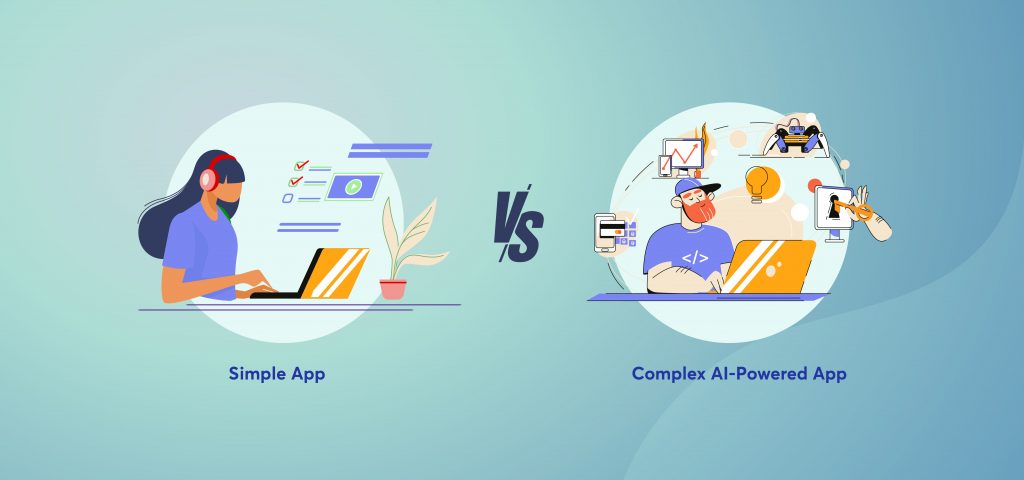
For instance, if you need a complex application incorporating AI & ML, you’d obviously need a highly skilled team of developers who will end up spending a lot more time than they would do for a simple app, which translates to a higher development cost.
The cost of developing an app with basic features is considerably lower than a complex app with advanced features. Basic features such as a simple UI, basic functionality, and limited user interactions are relatively easy to develop and require less time and effort. As a result, the cost of developing such an app is lower compared to a more complex app.
The development cost can also vary depending on the type of features required. For example, a social networking app like Whatsapp, with features such as in-app messaging, and video calling, will require more time and effort to develop than a simple utility app.
In addition to functionality, the number of features also impacts the development cost. The more features an app has, the more time and resources are required to develop it. Furthermore, adding features after the development process begins can increase the development time and cost.
#4. Location of Development Team
When you’re planning to develop a mobile app, the location of the development team can impact the cost. In general, hiring a local team is typically more expensive than outsourcing to a team in a different country. That’s because the cost of living and salaries vary greatly between different countries.
For instance, a development team based in the United States or Europe will cost more compared to a team based in India or Ukraine because of the lower cost of living and salaries in these regions.
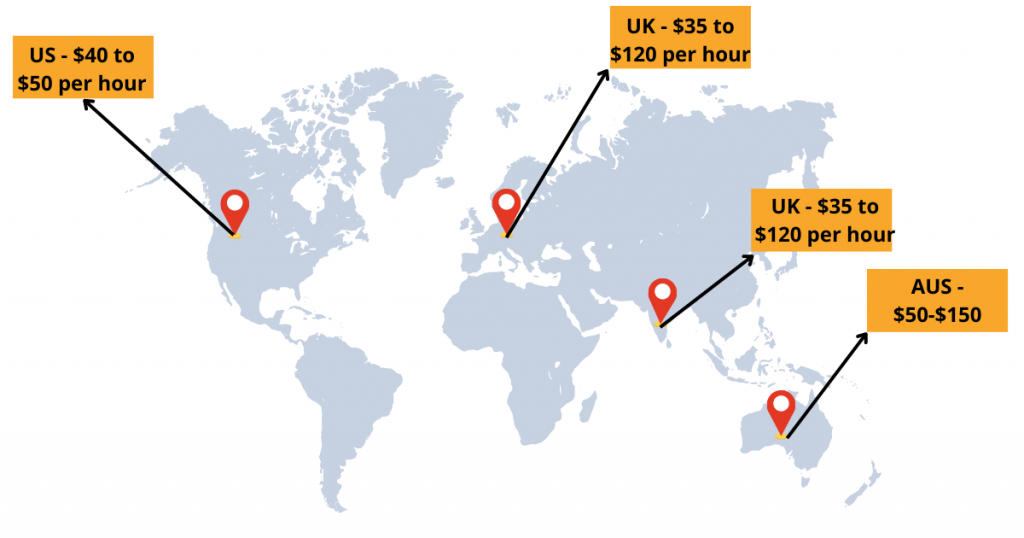
Outsourcing to a development team in a different country can help you reduce the development cost without sacrificing the quality of the app. However, you must carefully evaluate potential development partners to ensure they have the necessary skills and experience to deliver a high-quality product. For more information, check out the blog on the top countries to outsource your development project and find the perfect team for your needs.
#5. Legal Requirements
Depending on where you plan to launch the app and your target audience, you will have to comply with certain legal requirements. Compliance with these regulations often requires additional security measures, which can increase the development cost.
For instance, if your target audience is from the European Union, the app has to comply with the GDPR regulation. Similarly, if you’re developing a healthcare app for users in the United States, you may need to comply with the Health Insurance Portability and Accountability Act (HIPAA) regulations to protect sensitive user data.
Additionally, intellectual property (IP) laws can also impact the cost. If your app uses third-party content such as images, videos, or music, you need to ensure you have the necessary rights to use them. Failure to do so can result in legal consequences and additional costs to resolve the issue.
Types of Mobile Apps and Their Development Costs
Mobile apps are broadly classified into native, hybrid, and cross-platform apps. Here’s an overview of each type and their respective development costs:
1. Native Apps
Native apps, as the name suggests, are built specifically for a single platform, such as iOS or Android. These apps have access to the full set of platform-specific features and functionalities, resulting in high performance and better user experience.
Native app development costs are typically higher compared to other types of apps due to the platform-specific development requirements. The cost of developing a native app can range from $20,000 to $500,000, depending on the factors mentioned previously.
Pros:
- High performance and speed
- Access to a full set of platform-specific features and functionalities
- Better user experience
Cons:
- Higher development costs compared to other types of apps
- Longer development time due to platform-specific development requirements
- Separate development teams are required for different platforms
2. Hybrid Apps
As the name suggests, hybrid apps can be deployed across multiple platforms, making them less expensive than native apps. Hybrid apps are built using a combination of web technologies (HTML, CSS, and JavaScript) and native app elements.
The lower development cost of hybrid apps can be attributed to the ability to have a single codebase for multiple platforms. The cost of developing a hybrid app can range from $10,000 to $250,000, depending on the complexity of the app and the development team’s location.
Pros:
- Lower development costs compared to native apps
- Cross-platform compatibility
- Faster development time
Cons:
- Limited access to platform-specific features and functionalities
- Lower performance and speed compared to native apps
- Less control over user experience
3. Cross-Platform Apps
Cross-platform apps are built using tools and technologies that allow for the development of a single codebase that can be deployed across multiple platforms, including iOS, Android, and sometimes even web browsers. Cross-platform app development costs are usually lower than native apps due to the ability to reuse a single codebase. The cost of developing a cross-platform app can range from $10,000 to $200,000, depending on the complexity of the app and the development team’s location.
Pros:
- Lower development costs compared to native apps
- Cross-platform compatibility
- Faster development time compared to native apps
- Can access some platform-specific features and functionalities
Cons:
- Limited access to some platform-specific features and functionalities
- Lower performance and speed compared to native apps
- Less control over user experience compared to native apps
App Development Cost in a Nutshell

5 Proven Strategies for Reducing Mobile App Development Costs
Developing a mobile application can be costly. Use these proven strategies to reduce development costs without sacrificing quality.
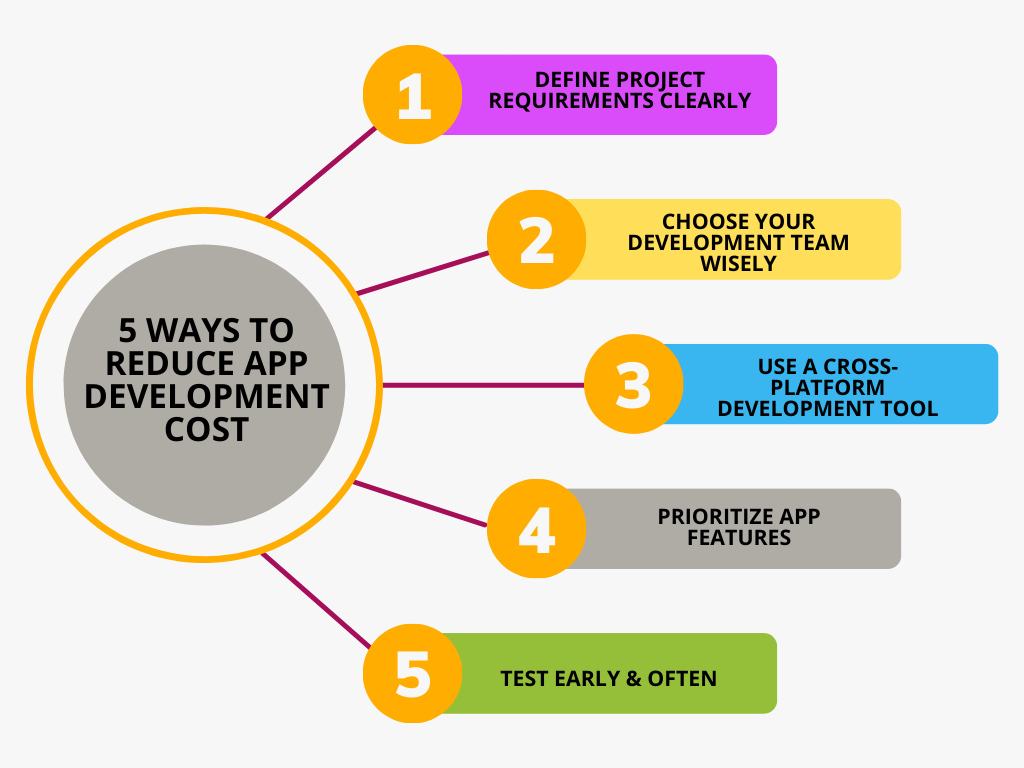
1. Define project requirements clearly
Taking the time to develop clear project requirements upfront can save you a lot of time and money in the long run. Before you begin the development phase, work with your team to define the app’s features, functionality, and target audience, and then document them in a detailed project scope document. You’ll ensure that everyone is on the same page and reduce the likelihood of scope creep and additional development costs.
2. Choose your development team wisely
Choosing the right development team is crucial to the success of your app development project. Look for a development team with experience in the type of app you want to build and check their portfolio to ensure they have the skills and expertise you need. Additionally, consider outsourcing development work to countries with lower development costs.
3. Use a cross-platform development tool
If possible, use a cross-platform development tool, such as React Native, Xamarin, or Flutter. These tools can save you time and money by allowing you to build a single codebase that can be deployed across multiple platforms, which eliminates the need to develop separate native apps for each platform, thereby reducing development costs.
4. Prioritize app features
Prioritize app features to focus on the most critical features and functionalities and reduce overall development costs. Work with your development team to identify the must-have features and functionalities, and prioritize them based on user needs and business goals. `
5. Test early and often
Test the app early and often to identify and fix issues early in the development process, reducing the likelihood of costly rework. Implement an agile development process and use automated testing tools to ensure that your app is thoroughly tested at each stage of development. Here is a complete checklist for mobile app testing.
Frequently Asked Questions
How much does it cost to develop an Android app in 2023?
As mentioned previously, the cost to develop an app varies depending on several factors, including the app’s complexity, features, functionality, and the development team’s location and experience. According to industry estimates, the average cost to develop a simple Android app ranges from $5,000 to $20,000, while a complex app can cost anywhere from $20,000 to $100,000 or more.
However, these figures can vary widely. It is crucial to define clear project requirements and work with an experienced development team to obtain an accurate cost estimate for your specific project.
2. How long does it take to build a mobile application?
Development time taken can vary widely depending on various factors, including the app’s complexity, features, functionality, and platform. Apart from these, factors like team size, skillset, and availability can also affect the development timeline.
For instance, a simple mobile app with limited features can take between 2-4 months to build, while more complex apps can take up to 12 months or more. However, it’s crucial to note that development timelines can vary significantly and are heavily dependent on the specific requirements and constraints of each project.
To Sum Up
In conclusion, developing a mobile app in 2023 is an essential business strategy, but it can be costly. Understanding the factors that affect the cost of mobile app development, such as platform, complexity, features, and functionality, is critical to creating a realistic budget.
Mobile app development costs have been steadily increasing over the past few years due to the increasing complexity of apps and the need for more sophisticated features. The average cost of developing a simple mobile app in 2020 ranged from $10,000 to $50,000, while the cost of developing a complex app could range from $50,000 to $250,000.
As we move into 2023, we can expect these costs to continue to rise, especially as new technologies emerge and the competition in the mobile app market increases. However, the use of low-code or no-code platforms may help to reduce the overall cost of app development by allowing for faster development times and requiring less specialized knowledge.
However, you can reduce mobile app development costs by creating a clear project scope, prioritizing features and functionalities, choosing the right development platform, and outsourcing development to experienced developers.
Ultimately, it’s essential to carefully consider your mobile app development goals and budget and work with experienced developers to ensure the best possible outcome. By taking the time to understand your project requirements and budget, you can make informed decisions that will help you to achieve your business objectives and maximize the return on investment from your mobile app development project.
